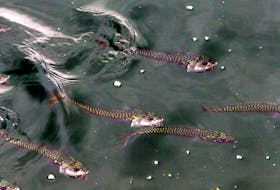It protected St. John’s harbour from U-boat attacks during the Second World War and now it just might be in a massive, tangly pile in the city’s east end.
What looks like an anti-submarine net used to stifle offences by Nazi subs sits rusting in the White Hills, between a developed trail and the foundation of the radio tower the U.S. Army once operated.
It’s one of the oddities The Telegram has come across in the area as it endeavours to find out more about the military waste dumped there.
People who’ve seen the heap or heard descriptions of it say it’s a submarine net, although official confirmation was not available by press time.
If it is indeed one of the security screens used to literally keep the enemy at bay, there are some who feel the net — or at least a section of it — should be preserved because of its historical significance.
Frank Galgay, a St. John’s councillor and author of numerous history books, is one of them.
“It would be good to have it retained and as a centrepiece for part of our history and for this generation that’s coming up to show how it played a very important role,” he said.
He suggests putting part of the net in The Rooms, at the Marine Institute or on a Grand Concourse storyboard.
The U-boat barrier is a quilt of countless cable rings, with steel cord about an inch thick.
The pile it’s in reaches six feet high in some places and its sprawl extends 40 or 50 feet.
There is next to no give in the rings, as they move only an inch or two when pulled.
The net is so large it can be spotted from a kilometre above on Google Earth.
It would have to have been heavy and massive to shield St. John’s from submarine torpedoes.
There is at least one documented incident where the screen worked.
According to “The First Landfall: Historic Lighthouses of Newfoundland and Labrador,” a U-Boat’s torpedo was “caught without exploding in the submarine net strung across The Narrows at Chain Rock” on March 3, 1942.
The 1994 book — written by David Molloy — says that torpedo was the second one fired. The first exploded on the red cliff right below the Fort Amherst lighthouse.
The keeper’s family was quickly moved to town, it states.
Capt. Joe Prim of St. John’s was in the merchant navy during the Second World War, sailing in and out of the harbour.
He says there was actually a network of submarine nets in place, with neither spanning the entire distance from Chain Rock to Fort Amherst.
“I think there were three in The Narrows, so we could (enter the harbour) in between them,” Prim says, adding that the mesh shields were held in fixed positions with the netting below the surface and buoys above.
Only a cable went from one side of The Narrows to the other, he explains. It was raised to block the harbour and keep enemy ships out.
Prim, who joined the merchant navy at 16 in 1943 and went on to become a master mariner, says the nets served an important purpose and prevented the Germans from doing damage to St. John’s and the ships docked at the old finger piers that jutted out into the harbour.
Acknowledging that the size of the net makes it impossible to preserve the whole thing, he believes at least part of it should be saved.
“Just as a reminder that there was nets there,” he says, noting anti-torpedo nets were also used in Argentia during the Second World War.
A number of historians declined to be interviewed about the net, as it didn’t fall into their areas of expertise.
Each of them agreed that at least a portion of it should be preserved.
Efforts to reach officials at The Rooms to determine the provincial museum’s interest in the net were unsuccessful.
The submarine screen wasn’t the only oddity The Telegram found in the White Hills this week.
It also discovered what’s left of an old army Jeep a stone’s throw from the netting.
It protected St. John’s harbour from U-boat attacks during the Second World War and now it just might be in a massive, tangly pile in the city’s east end.
What looks like an anti-submarine net used to stifle offences by Nazi subs sits rusting in the White Hills, between a developed trail and the foundation of the radio tower the U.S. Army once operated.
It’s one of the oddities The Telegram has come across in the area as it endeavours to find out more about the military waste dumped there.
People who’ve seen the heap or heard descriptions of it say it’s a submarine net, although official confirmation was not available by press time.
If it is indeed one of the security screens used to literally keep the enemy at bay, there are some who feel the net — or at least a section of it — should be preserved because of its historical significance.
Frank Galgay, a St. John’s councillor and author of numerous history books, is one of them.
“It would be good to have it retained and as a centrepiece for part of our history and for this generation that’s coming up to show how it played a very important role,” he said.
He suggests putting part of the net in The Rooms, at the Marine Institute or on a Grand Concourse storyboard.
The U-boat barrier is a quilt of countless cable rings, with steel cord about an inch thick.
The pile it’s in reaches six feet high in some places and its sprawl extends 40 or 50 feet.
There is next to no give in the rings, as they move only an inch or two when pulled.
The net is so large it can be spotted from a kilometre above on Google Earth.
It would have to have been heavy and massive to shield St. John’s from submarine torpedoes.
There is at least one documented incident where the screen worked.
According to “The First Landfall: Historic Lighthouses of Newfoundland and Labrador,” a U-Boat’s torpedo was “caught without exploding in the submarine net strung across The Narrows at Chain Rock” on March 3, 1942.
The 1994 book — written by David Molloy — says that torpedo was the second one fired. The first exploded on the red cliff right below the Fort Amherst lighthouse.
The keeper’s family was quickly moved to town, it states.
Capt. Joe Prim of St. John’s was in the merchant navy during the Second World War, sailing in and out of the harbour.
He says there was actually a network of submarine nets in place, with neither spanning the entire distance from Chain Rock to Fort Amherst.
“I think there were three in The Narrows, so we could (enter the harbour) in between them,” Prim says, adding that the mesh shields were held in fixed positions with the netting below the surface and buoys above.
Only a cable went from one side of The Narrows to the other, he explains. It was raised to block the harbour and keep enemy ships out.
Prim, who joined the merchant navy at 16 in 1943 and went on to become a master mariner, says the nets served an important purpose and prevented the Germans from doing damage to St. John’s and the ships docked at the old finger piers that jutted out into the harbour.
Acknowledging that the size of the net makes it impossible to preserve the whole thing, he believes at least part of it should be saved.
“Just as a reminder that there was nets there,” he says, noting anti-torpedo nets were also used in Argentia during the Second World War.
A number of historians declined to be interviewed about the net, as it didn’t fall into their areas of expertise.
Each of them agreed that at least a portion of it should be preserved.
Efforts to reach officials at The Rooms to determine the provincial museum’s interest in the net were unsuccessful.
The submarine screen wasn’t the only oddity The Telegram found in the White Hills this week.
It also discovered what’s left of an old army Jeep a stone’s throw from the netting.









